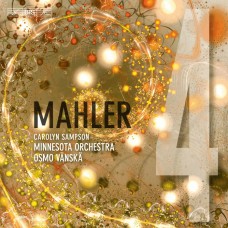|
馬勒:第四號交響曲
卡洛琳.桑普森 女高音
歐斯莫.凡斯卡 指揮 明尼蘇達管弦樂團
馬勒的前四首交響曲中有許多的主題旋律來自於他為民間詩歌集(少年的魔法號角
Des Knaben Wunderhorn)的譜曲. 例如: 在第四號交響曲是圍繞著一首他在八年前於1892年寫(天堂般的生活 Das himmlischeLeben)的歌而建構的. 這首歌呈現一個孩子對天堂的想像並且在前三個樂章都有提示. 在第四樂章中, 被標示著”非常舒適的”, 一位女高音在馬勒的指示下以寧靜, 不刻意模仿但帶著孩童的表達方式獨唱整首歌.
此交響曲雖然缺少長號和低音號, 但這是為一個典型的後浪漫時期大型管弦樂團而寫, 其中包含一段使用多種打擊樂器包括雪橇鈴鐺和鐘琴的音樂. 馬勒音樂的力道在此運用的比較透明與輕度, 更類似室內樂或莫札特或海頓的18世紀音樂模式. 第四號交響曲成為馬勒最受喜愛的作品之一, 在此專輯由歐斯莫.凡斯卡指揮明尼蘇達管弦樂團演奏, 加上有如天使般聲音的英國女高音卡洛琳.桑普森演唱.
Minnesota Orchestra
OsmoVanska
Carolyn Sampson, soprano
In Gustav Mahler's first four symphonies many of the themes originate in his own settings of folk poems from the collection Des Knaben Wunderhorn (The Boy's Magic Horn). A case in point, Symphony No. 4is built around a single song, Das himmlische Leben (The Heavenly Life) which Mahler had composed some eight years earlier, in 1892. The song presents a child's vision of Heaven and is hinted at throughout the first three movements. In the fourth, marked ‘Sehrbehaglich' (Very comfortably), the song is heard in full from a solo soprano instructed by Mahler to sing: ‘with serene, childlike expression; completely without parody!'
The symphony is scored for a typically large, late-romantic orchestra (though without trombones and tuba) and an extensive percussion section which includes sleigh bells as well as glockenspiel. However Mahler mostly deploys his forces with a transparency and lightness more akin to chamber music or eighteenth-century models like Mozart or Haydn. The Fourth has become one of his best-loved symphonies, and is here performed by Minnesota Orchestraand Osmo Vanska, joined by the angelic voice of English soprano Carolyn Sampson.
Gustav Mahler (1860—1911)
Symphony No. 4 in G major (1899—1900)
1 ) I. Bedachtig. Nicht eilen 17'01
2 ) II. In gemachlicher Bewegung. Ohne Hast 9'28
3 ) III. Ruhevoll (Poco adagio) 23'00
4 ) IV. Sehr behaglich 9'09
TT: 59'25 |
|



